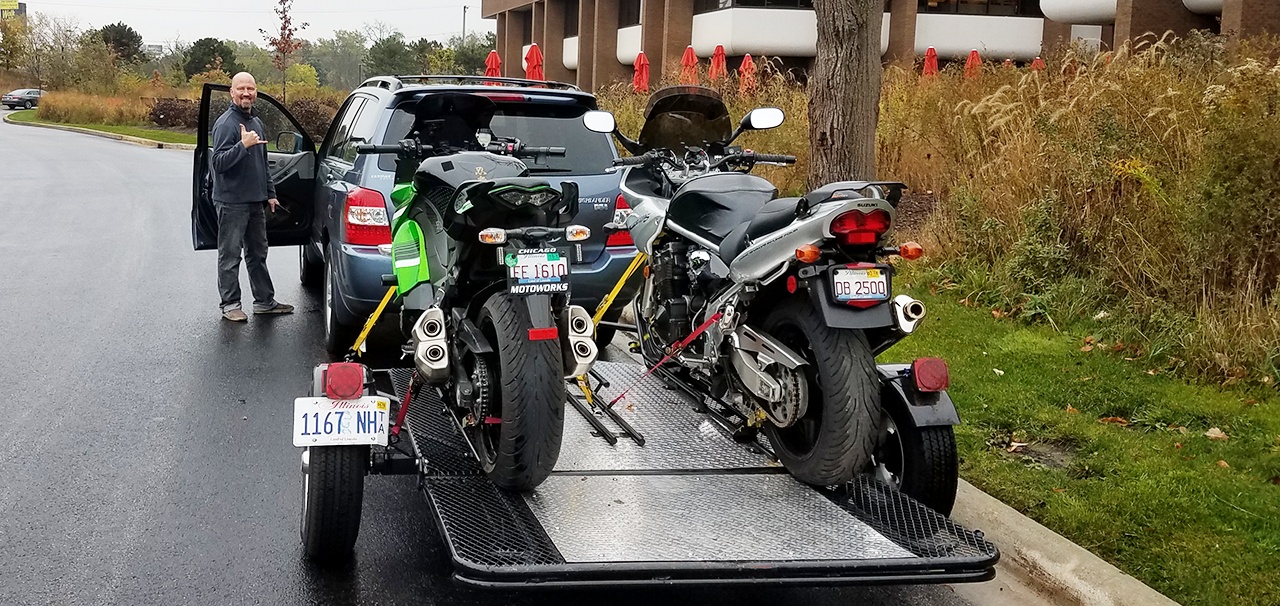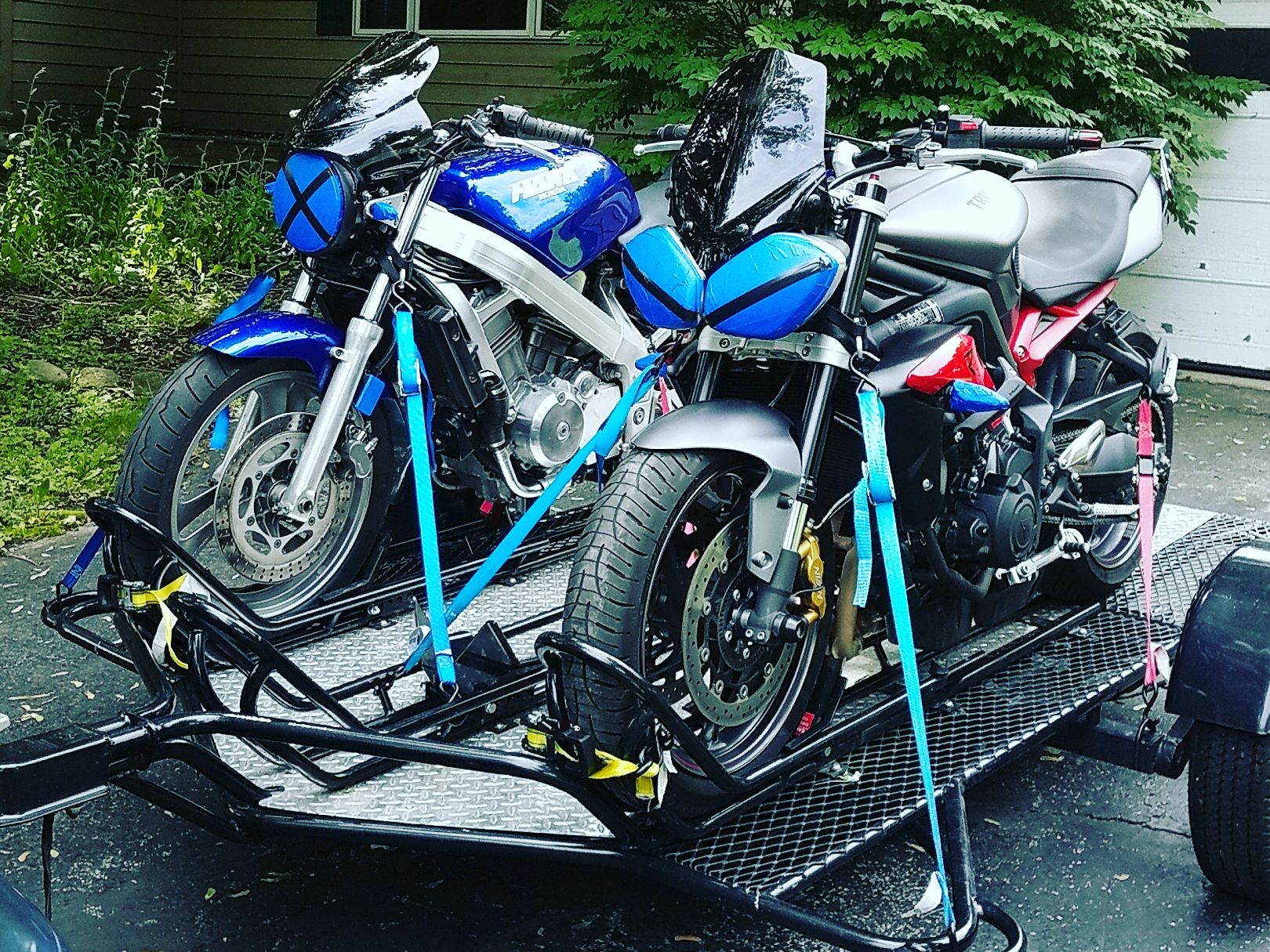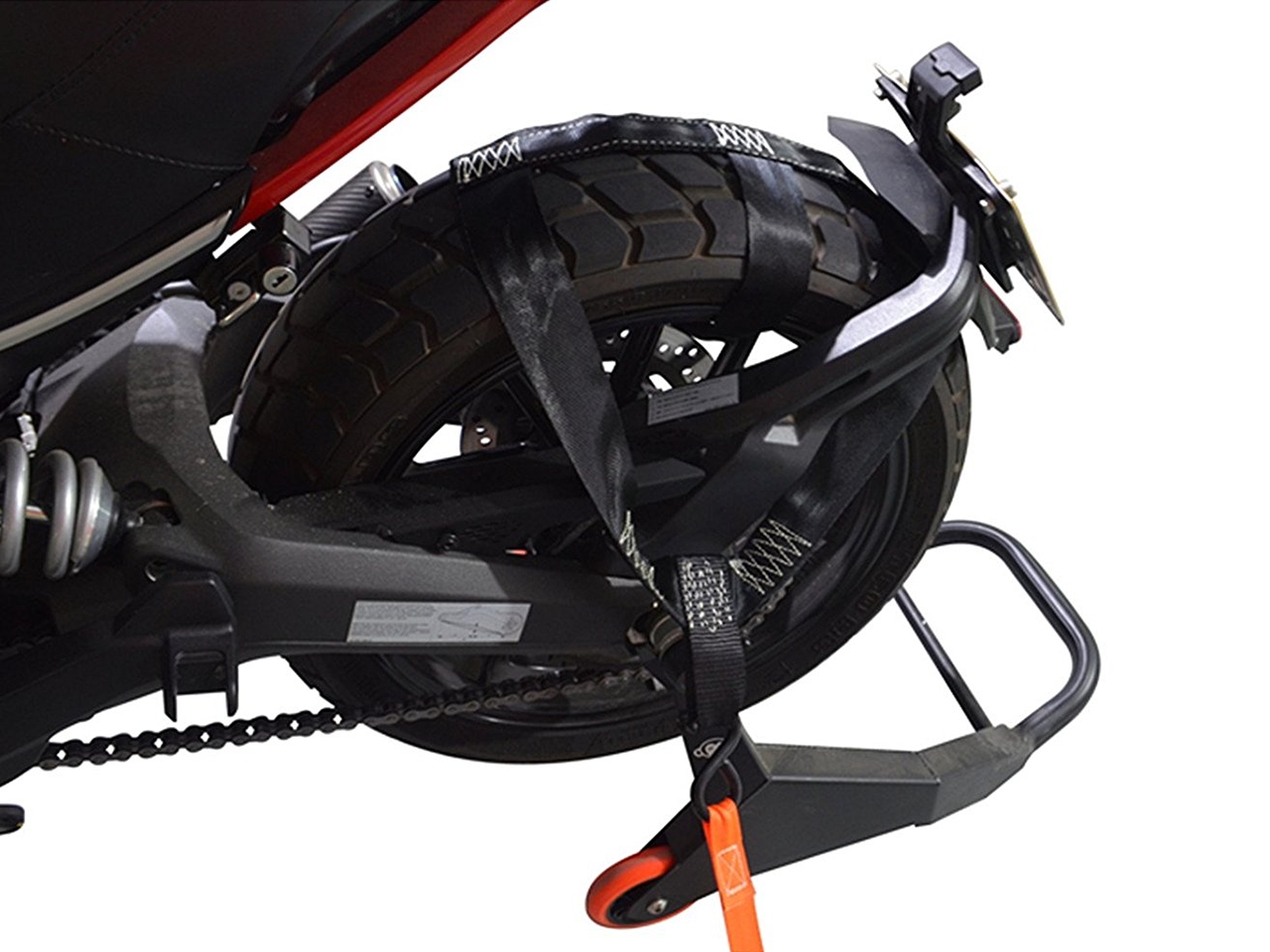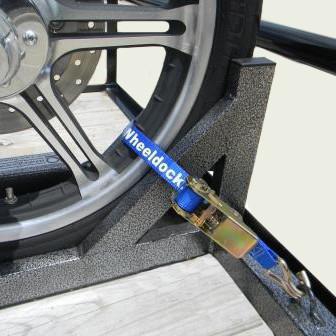For kicks, check out our FTC disclosure here. Updated Dec 3, 2025 ...
Motorcycle Trailering Is All About Bondage
[*Ahem*] I mean ... if your bike is into that sort of thing, not that I'm judging (I'm not! I swear). It's just that securing a motorcycle on a trailer before towing it to that next big ride can mean a lot of thoughtful prep work and, well, straps of various purpose. The kind of "bondage" I'm focused on involves ratchet straps, tie downs and loop straps, otherwise referred to as soft straps.
If you're wondering how to secure a motorcycle for trailering without drama, you're in the right place.
The range of opinions (regardless of experience) about how many tie-downs a rider should use when trailering is pretty vast. One of my own friends/mentors nary uses more than three and has yet to report ever having to pull over for fear of one coming loose. Others in our riding circle sometimes buy every available ratchet strap from every nearby automotive store before mummifying the entire chassis and welding the bike directly to their trailer's base (kidding).
“How to secure a motorcycle on a trailer, riders learn, comes down to smart angles, strong straps and a quick check after the first few miles.”
The point I'm aiming to make here is that neither approach is wrong. I, myself, consider all factors, as I'll explain in a moment. Depending on your bike, trailer and prerogatives, this introduction sets a wide boundary for your own stationary testing.
Measure Motorcycle Twice, Configure Trailer Once
I mention a friend above who only uses three straps to trailer his ride.
At the very least, fastening a motorbike to any tow setup should involve triangulation of the front end with slight compression of the front forks using the upper triple clamp. Facing the front of the motorcycle, imagine two straps spanning the left and right sides diagonally downward. Tighten those securing points enough to slightly collapse the front suspension, creating a stiff, sturdy reaction over mid-travel bumps.
This is a straightforward example of how to secure a front end so it resists both brake dive and chatter on rough roads.
We still have one more base-level point you shouldn't ignore, though ... namely, the back end. If you have a center stand, some tow companies will throw a towel over the seat and ratchet a third strap directly across the rider position. Others, myself included, will loop straps on either side using the subframe, with no need for (sometimes non-existent) parking/wrenching luxuries.
Knowing how to secure the rear is about stabilizing the subframe and minimizing side-loads that can walk the tire.
I'll take this opportunity to go one step further and mention that my friend only uses lashing straps rather than ratchets. While he's never had issues (and you might not either), I check/tighten this format at every gas stop. It's likely due to my user error but the angle at which I cinched my lashing straps might also have caused the trouble.
When "installing" a motorcycle onto a trailer using straps of any kind, the goal is to set each strap, left to right and vice versa, as close to 45° as possible. This helps to equally displace momentum-driven tension both horizontally (left/right turns at intersections) and vertically (speed bumps, rough highway). For some bikes, especially naked models, this isn't an issue but for my Bandit 1200, getting the straps to 45° means torturing my beloved plastics.
Logical Trailer Solutions For "Awkward Fit" Motorcycles
Before I go into further detail about my own preferred strap count, let's solve the above matter. The market offers many soft/loop straps and some manufacturers design them specifically for motorcycling but one in particular really stands out. They're called Jeri Riggs ...
... and by parking my motorcycle on our three-rail trailer without the newly arrived Jeri Riggs installed, I was able to route my ratchet straps directly to where these 3k+ lbs. strength loop straps needed to be so that my motorcycle's fairing would remain intact.
How To Secure More Straps = Greater Stability (And Peace Of Mind)
In my introduction, I joke about a few cohorts who garnish nine-plus straps just to secure their track day pit bike. In truth, while I wouldn't likely be so paranoid, good on them for doing what they feel is necessary. For reasons unique to me, I use only two more points on the bike in addition to the four total basic securing points mentioned so far (two front, two rear).
Using the front wheel chock and a centrally located Jeri Rigg loop, I gently secure both the front and rear wheels using-surprisingly enough-wheel lashings. Because these two locations aren't under heavy stress, simple lashings operate as a perfect "worst-case scenario" safety net. Should any of my other properly situated defaults fail for one reason or another, the bike stays in place.
If you're teaching a friend how to secure a bike solo, wheel lashings add a forgiving safety layer.
Which Brings Me To Ratchet Strap Strength
This is a personal rule of mine, one that's proved noteworthy at the expense of other friends' bikes. No matter your preferred type, always buy straps that can carry the weight of your motorcycle plus at least another 1/2 of that figure. My Bandit 1200 weighs in at some 500+ lbs. (wet). My preferred ratchet straps support up to 900 lbs and have a known breakpoint over 1500 lbs.
“No matter your preferred type, always buy straps that can carry the weight of your motorcycle plus at least 1/2 of that figure.”
The side-to-side and vertical motion that trailering will introduce (and frequently, for that matter) exponentially raises the weight/tension requirements demanded of the straps. Do the math and buy just shy of overkill. The difference in cost will likely be nominal compared to "I'm looking in my rearview and ... wasn't there a bike on my trailer?"
Summary: How To Secure Your Motorcycle To A Trailer
I, myself, can confidently state that I'm a "six-strap man". Of those six, four are ratchet straps, connected at the front using the upper triple trees and toward the rear at the subframe. I use two more, each simple lashings, to secure the front and rear wheels for stability and safe keeping.
My thinking is that the first four (three if you rock an over-the-seat rainbow) are mandatory and that because the extra two at the wheels are lashing (easy enough), why the heck not?
Bottom line: knowing how to secure with six points delivers stability, redundancy and calm at highway speeds.
Some might say that's far too many, while others raise their eyebrows in fear that it's not enough. As I mention above, it's a bike-to-bike instance. Test and test again, making sure that everything remains stable (especially after the first fifteen minutes of travel) before keeping notes on precisely what your trailering scenario requires.

What Trailering Tips Do You Have?
With so many trailers on the market, riders share countless methods and ideologies. What approach do you take? Has it always worked out and if so, why? Your input is invited. Leave a comment and/or write an article!







Comments
All I ever use is two straps at the front. No problems yet.
You sure about that, Bob?
Here we are heading to the Ozarks together, using your trailer ;)
Click to enlarge ...
https://tro.bike/wp-content/uploads/2014/11/ozarks-motorcycle-rally-01.png
Being in the Motorcycle trailer business for years we have a set pattern for strapping bikes down. Four straps are usually enough to hold a bike in place even if it is a large touring bike if done correctly. Every bike is different, some are easy and some are difficult to even find a place to attach a soft loop for a strap. We always put two 1 inch straps on the front to hold the front of the bike firmly in the wheel chock. We do not compress the suspension very much at all, just a firm hold. Then 2 Two inch straps on the back pulling the bike forward into the wheel chock. Preferably as high as you can get them on the back but on some models that's no higher than the top of the frame at the bag guards. With this setup and the back straps firm the bike should not move at all. Just make sure its level and it should be good until you are ready to unload.
Great breakdown! As someone who's fairly new to trailering motorcycles to track days, this article hit home. The point about strap angles and fork compression is something I hadn't given much thought to before but it makes total sense now. I also appreciate the shoutout to lashing straps vs. ratchets ... been there with mid-ride tightening too!
I recently picked up one of these modular trailer kits to build my own setup and having the flexibility to configure tie-down points exactly where I need them made all the difference. Definitely agree: it's better to over-engineer for peace of mind than regret it mid-highway. Great post. Bookmarked!
Thoughts gone wild? Write an article!